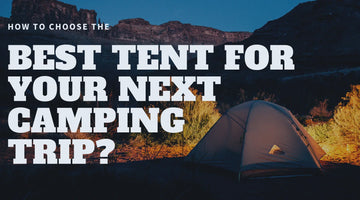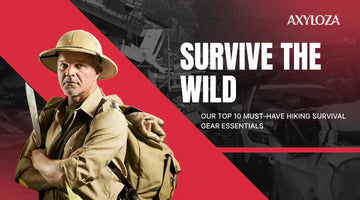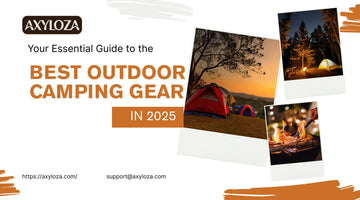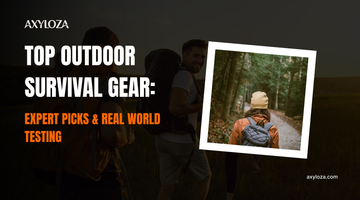Camping is a fantastic way to escape the hectic pace of daily life, immerse yourself in nature, and create lasting memories with friends or family. Central to any enjoyable camping experience is having the right tent—one that matches your needs, group size, weather, and your style of adventure.
Whether you’re leaning toward big tents for families, compact pop-up tents, or cutting-edge inflatable tents, making the right choice sets the stage for a cozy, hassle-free trip under the stars.
How to Choose the Right Tent
When it’s time to pick a camping tent, start by focusing on a few key factors:
- How many people are going?
- What kind of weather do you expect?
- How will you get to your site, hiking or driving?
Answering these questions helps determine the size, weight, and durability you’ll require.
Tent Size: Getting the Fit Right
Many tents are labeled according to their occupancy, such as 2-person, 4-person, or 6-person tents. However, these ratings are usually based on a snug fit, allowing little room for gear or comfort.
If you want a more spacious experience, especially for longer trips or to store equipment inside the shelter, always consider sizing up. For instance, a 4-person tent provides much more comfort for two people with their gear. For families or groups, big tents for camping deliver plenty of room to move, relax, and keep belongings organized.
Some family tents also feature multiple rooms divided by panels, offering privacy and separate sleeping spaces for children or adults. When camping with a larger group, multi-room cabin tents with tall vertical walls make changing clothes and standing up far easier, making them ideal for extended outings or car camping where weight is less of an issue.
Matching Your Tent to the Weather: 3-Season vs. 4-Season

Tents are constructed and rated for different weather conditions:
-
3-season tents are designed for moderate conditions—spring, summer, and fall. They offer good ventilation, keep you shielded from light rain, and typically pack lighter, making them suitable for most campers.
-
4-season tents are more robust, built to withstand harsh wind, cold, and snow. They’re perfect for winter camping or areas with unpredictable weather.
Many casual campers choose 3-season tents due to their lighter weight and versatility; they are sufficient for most destinations unless you expect heavy snow or powerful winds.
Weight and Portability: Backpacking vs. Car Camping
If you are backpacking or hiking to your campsite, the weight of your tent becomes a critical issue. Solo hikers often prefer tents weighing less than three pounds (about 1.5 kg), sacrificing some space for ease of transport. For couples sharing a tent, dividing the tent pieces between two backpacks can help distribute the weight more comfortably.
For those who are car camping or have a short walk to the site, weight is less of a concern. Here, you can go for larger, more luxurious tents—bringing along comforts like air mattresses, cots, and camping furniture without worrying about bulk.
Why Choose Big Tents for Camping?
Big tents are invaluable for group and family trips. The best family camping tents allow everyone to move around freely, offer generous standing room, and feature separated living and sleeping quarters for privacy and comfort. Some models have built-in porches or vestibules that serve as sheltered entryways or gear storage areas. Features like blackout curtains or darkened fabric in bedrooms are great for those who prefer to sleep past sunrise.
Cabin tents with near-vertical walls enable campers to stand up and walk around inside, which makes them ideal for longer stays or sheltering from bad weather. Explore cabin tents or multi-room options if you value living space and easy movement.
Inflatable Tents: Hassle-Free Setup
Inflatable tents are a modern solution for campers looking for simplicity. These tents use air beams instead of traditional metal or fiberglass poles, dramatically reducing setup time. Instead of threading and assembling poles, you inflate the structure using a manual or electric pump.
Pros:
- Set up in just a few minutes
- Fewer fiddly components and less risk of losing or breaking poles
- Great for families or casual campers seeking a straightforward setup
Cons:
- Heavier than traditional pole tents due to air beam reinforcement
- Tend to be more expensive
-
Require a pump (sometimes supplied, sometimes separate)
If quick assembly and convenience are top priorities, or you're embarking on a relaxed, short trip, an inflatable tent is a smart, practical choice.
Pop-Up Tents: Perfect for Beginners and Quick Getaways
Pop-up tents are designed for immediate setup. When removed from the bag, flexible poles spring into shape automatically, making the tent instantly ready. These tents are especially popular for music festivals, kids’ sleepovers in the backyard, or weekends at the beach.
While pop-up tents aren’t as robust as traditional models in strong winds or heavy rain, they offer convenience for fair-weather camping.
They're lightweight, compact, and easy to pack—ideal choices for beginners or spontaneous outdoor plans.
Waterproof Tents: Stay Dry, Stay Happy
Unexpected rain can quickly ruin a camping trip if your tent isn't up to the task. A good waterproof tent will feature:
- Strong, coated fabrics (like polyester or nylon) that repel rain and dry quickly
- Taped, sealed seams to prevent leaks
- Durable zippers and a full-coverage rainfly for extra security
-
Breathable construction to minimize condensation inside
Look for a hydrostatic head rating of at least 1500mm for moderate rain, with higher ratings (3000mm and above) offering better resistance for heavy downpours.
Quality waterproof tents help keep sleeping bags, electronics, and clothes dry—and help everyone enjoy the adventure despite the weather.
Types of Tents: Find What Suits Your Style

Below, find a summary of popular tent types and their best uses:
|
Tent Type |
Best For |
Main Features |
|
Dome tent |
All-around camping, stability in wind |
Simple structure, easy pitching, good for 2-4 campers |
|
Cabin tent |
Family groups, long stays |
High ceilings, multi-room options, spacious interiors |
|
Pop-up tent |
Festivals, beach trips, occasional use |
Instant setup, lightweight, minimal weather resistance |
|
Inflatable tent |
Quick setup, family outings |
Air beams, rapid inflation, slightly heavier |
|
Tunnel tent |
Large families/groups, basecamp |
Multiple bedrooms, high stability, great weatherproofing |
|
Backpacking tent |
Solo adventurers, hikers |
Ultralight, compact, minimalist layout |
Comparing Top Brands
When it’s time to shop for a new camping tent, certain brands reliably deliver quality, innovation, and support across different categories:
- MSR: Well-known for lightweight, technical tents perfect for backpackers and experienced hikers.
- Coleman: Offers budget-friendly, easy-to-use tents, excellent for beginners, families, and occasional campers.
- REI: Features durable, versatile models with thoughtful designs and excellent weather protection.
- The North Face: Renowned for high-performance, durable tents suited for challenging conditions and frequent use.
-
Outwell, Berghaus, and Hi-Gear: Popular for large, innovative family and inflatable tents, offering models with blackout rooms and air beam technology.
Before you buy, browse options from these trusted names and compare features like ease of setup, weatherproofing, space, and price.
Tips for Making Your Camping Trip Memorable
- Always practice pitching your new tent at home before heading out.
- Bring a groundsheet to protect your tent floor and add insulation.
- Pack repair kits for emergencies—containing patches, seam sealer, and spare stakes.
-
Consider your campsite’s terrain and make sure your tent matches the environment.
Final Thoughts
There’s no one-size-fits-all best camping tent. The right choice depends on your needs, travel method, group size, weather expectations, and comfort preferences. Whether you prioritize extra space, speedy setup, lightweight portability, or weather endurance, choosing wisely will enhance your camping trip and guarantee lasting memories.
Find the right tent for your next trip—whether you need room for the whole family or a lightweight option for travel.
Shop now at Axyloza and get ready for your next outdoor adventure!
FAQs
Q1. How do I choose the best tent?
Pick a tent that fits your group size, expected weather, and travel mode, then review extra features that match your camping style.
Q2. What are the best camping tents?
The best tents depend on your needs: families prefer large tents with ample space, while hikers opt for lightweight models. Pop-up tents and simple domes are popular for beginners.
Q3. Which brands make reliable tents?
Consider brands like MSR, Coleman, REI, The North Face, and Berghaus—they all offer highly rated options for different budgets and group sizes.
Q4. How can I make sure my tent is waterproof?
Look for tents with treated fabrics, sealed seams, and a quality rainfly. Check product details for hydrostatic head ratings and stormproof reinforcements.




